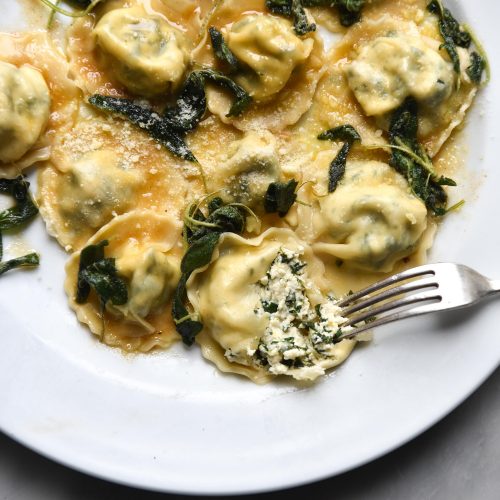
Gluten free spinach and ricotta ravioli
All cup measurements are in Australian cups
Ingredients
For the pasta:
- 180 g (1 3/4) cups tapioca flour
- 160 g (1 cup) brown rice flour
- 1 1/4 teaspoons xanthan gum
- 3 extra large eggs
- 50-60 g water only as necessary
For the ricotta:
- 2 (2000ml) litres milk
- 1/2 cup (125ml) acid of choice lemon juice, white vinegar
- 1 teaspoon table salt
- OR
- 350-450 g firm deli ricotta if you don’t need it to be lactose free
For the spinach ricotta filling:
- 1 batch of ricotta 350-450g ricotta, very firm
- 100 g blender parmesan fresh parmesan that has been processed to a fine crumb in a food processor or Nutribullet
- 100-150 g spinach blanched, drained and finely chopped
- Salt and pepper to taste
- Zest of 1/2 – 1 lemon to taste
- Lemon juice to taste
- 1/4 - 1/2 teaspoon ground nutmeg to taste
For the brown butter and crispy sage topping:
- 100 g butter
- 1-2 bunches sage
Instructions
TO MAKE THE RICOTTA FILLING
- If you’re making the ricotta from scratch, click on the ricotta recipe link in the notes section to make the ricotta.
- Blanch the spinach in boiling water before allowing to drain. Once cooled a little, squeeze all the liquid you can out of it before chopping thoroughly. Place in a mixing bowl.
- Add the ricotta and remaining ingredients to the mixing bowl and stir to combine. Adjust the seasoning to taste, noting that the flavour won’t dramatically amplify while being cooked (meaning you should flavour it robustly now).
- Set aside or place in the fridge while you make the pasta.
TO MAKE THE PASTA DOUGH:
- Combine the flours and xanthan gum in a large mixing bowl. You can also do this on the table (as is traditional) but I always get excited and under-form my flour well. Either way, form a well in the flour and add in the eggs. Use a whisk to break up the yolks, and then begin to incorporate the eggs into the flour.
- Once the eggs are mostly incorporated (the mix will look clumpy) add in the water, using one hand to bring the dough together. Keep adding water only as necessary, noting that you really need to work the dough to bring it together. If you’re lazy and just keep adding liquid, the pasta will be a lot harder to work with. Best to put in the effort early.
- Once you have brought the dough together into a relatively smooth ball, tear off a piece and cover the remaining pasta in cling film or a slightly dampened tea towel.
- Lightly flour the bench with tapioca flour, using as much as necessary, whenever necessary.
- Use your rolling pin to roll the piece of dough thin enough to get through the thickest setting of your pasta machine. After getting it through the thickest setting (mine is a 7) fold it and run it through the machine again. Continue rolling it through on decreased width settings until it’s thin enough for your tastes, noting that it swells during cooking (so go a little thinner than you think.) I like to get mine through smoothly at setting 2 or 3 on my Jamie Oliver machine.
- I don’t have a special technique – I keep running the pasta through until it’s smooth and (ideally) has relatively straight edges. You won’t toughen the pasta from rolling, so you can re-roll as often as you see fit. If it’s wonky, you can start fresh. You can also add extra water to very dry pieces that have toughened from being rolled out.
TO FILL THE RAVIOLI:
- Once you have two long, thin sheets of even width, place small teaspoon-ish blobs of ricotta mixture evenly across the bottom sheet of pasta, leaving space between them. See the video in the notes section for a visual.
- Use a finger or pastry brush to lightly brush the pasta around the ricotta with water. Lay the second sheet of pasta on top. Seal the pasta sheets together in between the ravioli pieces. Working around slowly, seal the top pasta sheet onto the bottom around each individual ravioli, pushing all the air out as you go. If you leave air in the ravioli it will float as it cooks and is more likely to pop open.
- Make sure each ravioli is well sealed and then trim as you see fit. You can trim it into a square, or use a scone cutter to make circular ravioli. Continue working like this until all the pasta and filling is finished. If you have any leftover pasta dough, you can make it into fettuccine and fresh it for later.
- Continue like this until all the ravioli are finished.
TO FINISH THE RAVIOLI:
- Bring a large saucepan of well salted water to the boil. While you’re waiting, make the brown butter. Place the butter in a large skillet or pot over a low medium heat. Allow to cook and stir intermittently until the butter is deep brown in colour and smells nutty. Add the whole sage leaves while the butter is hot – they will sizzle up and become crisp within under a minute.
- Working in batches, gently lower pieces of ravioli into the water and cook for 2-3 minutes. It should be floating and the pasta should be soft and almost translucent. Gently drain with a slotted spoon and divide onto individual plates. Drizzle the brown butter atop each individual plate and top with some crispy sage leaves. Serve immediately.
Tried this recipe?Let us know how it was!